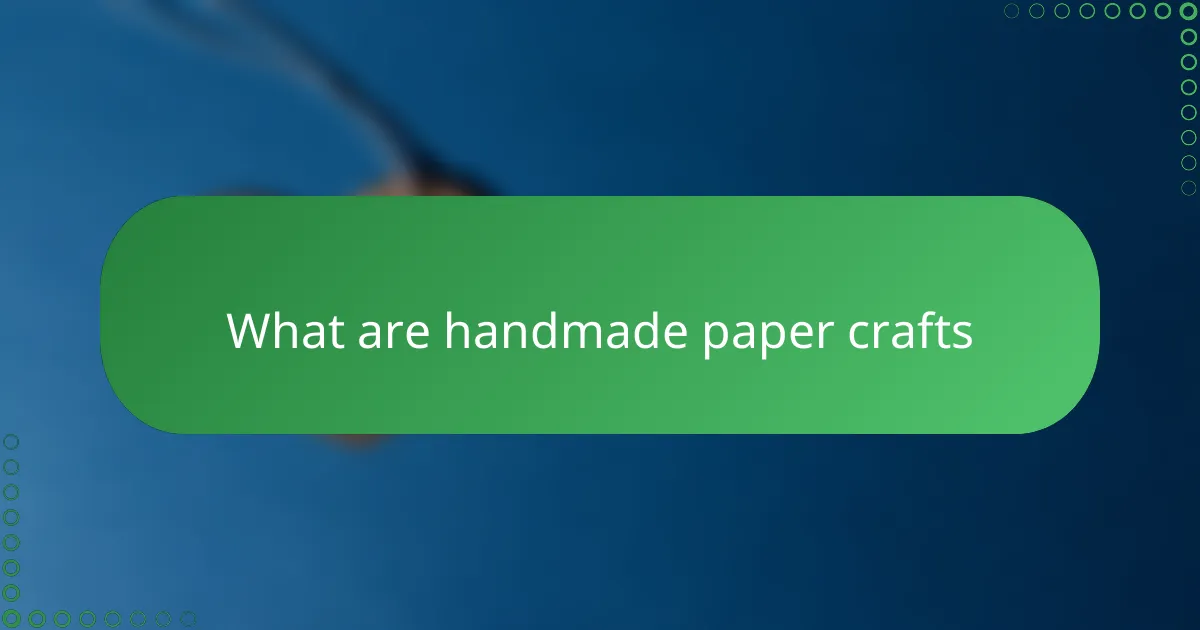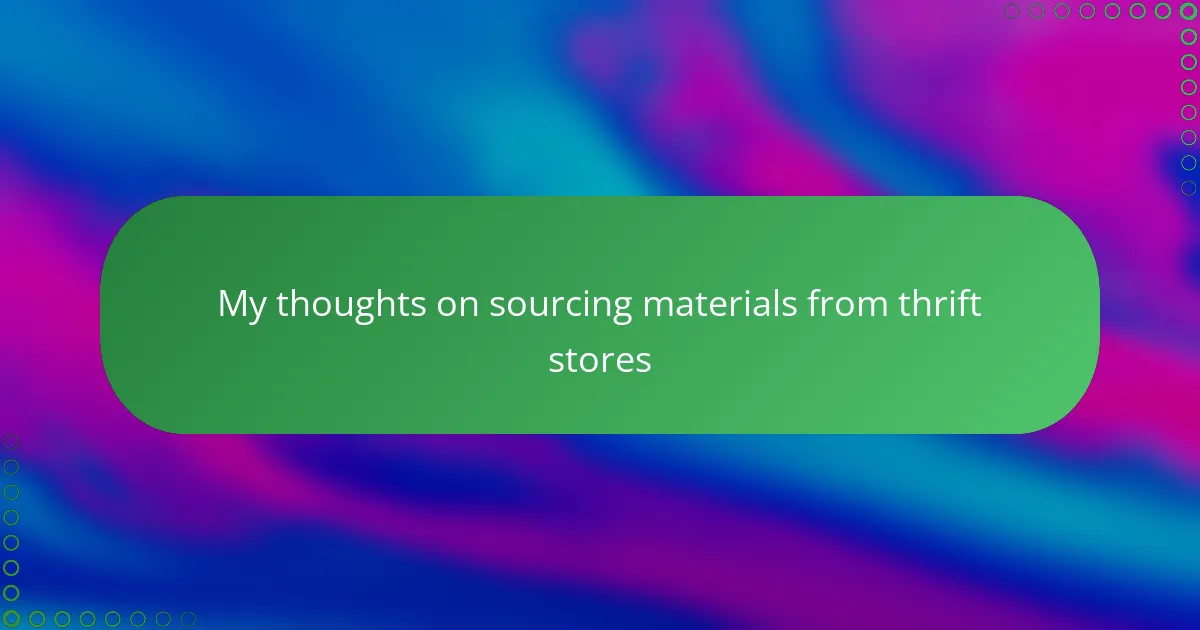Key takeaways
- Handmade paper crafts involve creative techniques like folding and decorating paper, resulting in unique, personalized items.
- Using recycled materials for crafts reduces waste and enhances artwork with unique textures and histories.
- Thrift store supplies are affordable and sustainable, allowing for creative exploration without a high cost.
- Inspiration can be found in ordinary materials; trusting your instinct can lead to meaningful and extraordinary creations.

What Are Handmade Paper Crafts
Handmade paper crafts are creations crafted with care and creativity, using paper as the primary material. These crafts often involve techniques like folding, cutting, layering, and decorating paper to produce unique items, such as cards, journals, or decorative pieces.
I find the process of making handmade paper crafts incredibly rewarding because each piece tells a story through its texture and design. Have you ever held a card or artwork that feels like it was made just for you? That personal touch is what sets handmade paper crafts apart.
What fascinates me most is how something as simple as paper can transform into an art form brimming with character and emotion. It makes me wonder—how many stories could be hidden in the sheets we casually toss aside every day?

Benefits of Using Recycled Materials
Using recycled materials in handmade paper crafts feels like giving new life to something that might otherwise be forgotten. I often find joy in transforming thrift store scraps into vibrant art—it’s a reminder that beauty can emerge from what others overlook. Have you noticed how this approach adds depth and history to each piece?
One of the biggest benefits, from my experience, is how recycled materials reduce waste and lessen the environmental impact of crafting. It’s satisfying to know that by repurposing old paper, I’m contributing to a greener world, even in a small way. Isn’t it amazing how creativity can align with sustainability so naturally?
Plus, recycled materials bring unexpected textures and patterns that you just can’t buy new. I love the thrill of discovering unique elements in thrift store finds—it sparks creativity and makes every craft truly one-of-a-kind. Don’t you think these little surprises make the crafting process much more exciting?

Why Choose Thrift Store Supplies
Thrift store supplies often carry a certain charm that new materials just can’t replicate. I’ve spent hours sifting through old books, magazines, and scraps, and there’s something thrilling about finding that perfect piece with its own history. Have you ever felt that spark of inspiration when a simple page or fabric suddenly holds a story waiting to be told?
Another reason I turn to thrift stores is the affordability. Crafting can get expensive quickly, but scoring materials at thrift stores lets me experiment freely without worrying about cost. Isn’t it liberating to create without constantly checking the price tag?
What truly makes thrift store supplies special, though, is their sustainability. Choosing these materials means I’m part of a creative cycle that honors resources already in circulation. It feels empowering to craft something beautiful while actively reducing waste—a small but meaningful way to care for the planet. Wouldn’t you agree that this conscious choice adds deeper value to the artwork?

How to Identify Useful Materials
When I hunt for materials at thrift stores, I always keep an eye out for papers that have an interesting texture or weight. Sometimes, what looks like a worn-out page can be exactly what I need for a unique handmade paper craft. Have you ever found yourself drawn to a particular sheet just because it feels different in your hands?
I also look for materials with potential—old book pages, scraps of fabric, or even vintage envelopes can be goldmines. From my experience, the trick is to imagine how these pieces might come together rather than judging them by their current state. Isn’t it fun to envision transforming something ordinary into something extraordinary?
One thing I’ve learned is to trust my intuition. If a material sparks a tiny idea or a feeling, it’s usually worth picking up. Even if I’m unsure at first, that little spark often leads to the most meaningful crafts. Do you find that your best creations come from those unexpected finds?

Tips for Sourcing from Thrift Stores
One tip I’ve found invaluable is to visit thrift stores regularly rather than just once in a while. New items come in all the time, and that steady stream keeps the possibilities fresh. Have you ever been pleasantly surprised by finding that perfect piece you didn’t even know you needed on a routine trip?
Another strategy I swear by is bringing a small kit with me—scissors, a pencil, and a notebook. It helps me quickly sketch ideas or cut sample scraps to see how they might work in a project. Do you think carrying tools on hand could make your thrift store hunts more intentional and productive?
Lastly, I try not to rush the process. Sometimes the best materials require some patience and a bit of digging through piles. I’ve lost track of how many gems I discovered simply by slowing down and really exploring every nook. Isn’t that part of the fun—getting lost in the hunt and letting creativity lead the way?

Personal Experiences with Thrift Sourcing
I remember the first time I found a stack of vintage sheet music at a thrift store—it was like uncovering a hidden treasure. There’s something deeply satisfying about turning those delicate pages into textured, eye-catching elements for my paper crafts. Have you ever felt that rush of excitement when a forgotten item suddenly becomes the heart of your project?
Sometimes, sourcing materials feels like a small adventure, wandering the aisles and imagining the stories behind each piece. I often catch myself smiling when I stumble upon something unexpected, like a faded map or an old greeting card, knowing they’ll bring unique character to my work. Isn’t it remarkable how these discoveries add both nostalgia and originality?
Of course, not every visit leads to a jackpot, but even the quiet moments of sifting through odds and ends teach me patience and creativity. From my experience, those times encourage me to see potential where others might see clutter. Have you noticed how this mindset shift transforms the whole crafting process into something even more meaningful?

Creative Ideas Using Thrift Materials
One of my favorite ways to use thrift store materials is turning old book pages into textured backgrounds for handmade cards or journals. The yellowed edges and slight imperfections tell a story, making each piece feel like a small treasure chest of history. Have you ever noticed how these aged papers add a warmth and depth that fresh stock simply can’t replicate?
I also love incorporating scraps of fabric or torn envelopes I find hidden among thrifted bundles. Sometimes a small patch with a faded pattern sparks an idea that leads to layering techniques or mixed-media effects in my paper crafts. It’s amazing how these unexpected elements bring a tactile richness that invites you to reach out and touch the art.
Then there’s the joy of repurposing entirely unconventional items—like using cut-up vintage maps or ticket stubs as decorative accents. These tiny details often become conversation starters and give my projects a unique personality. Have you ever been surprised how a simple, forgotten fragment can inspire an entire design? For me, that’s the true magic of sourcing from thrift stores.
